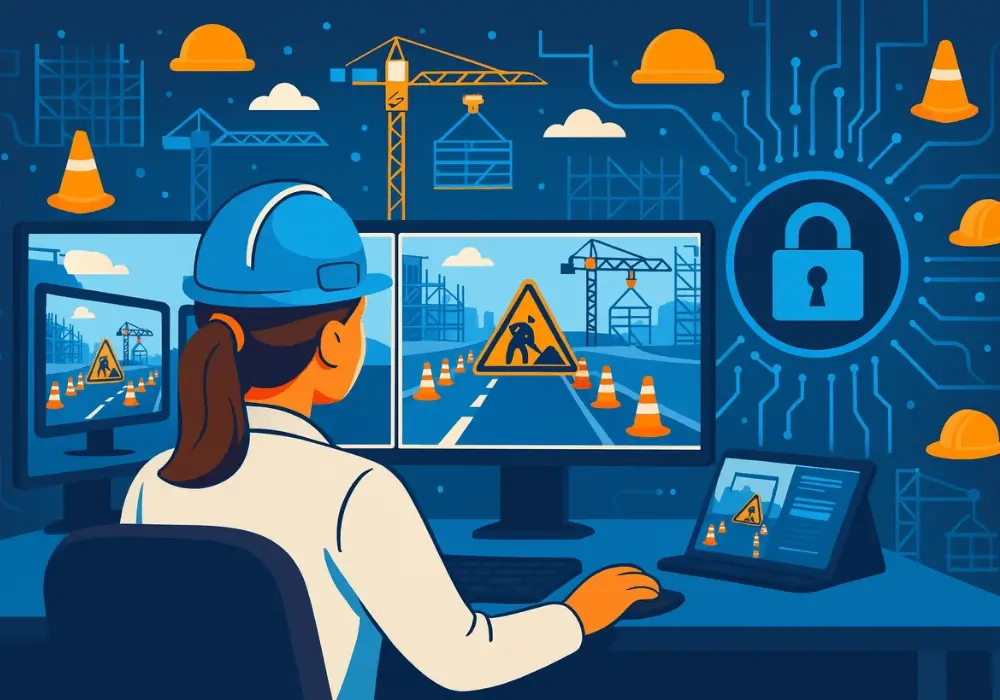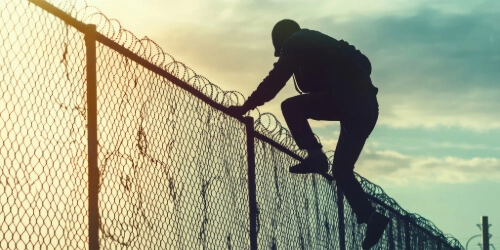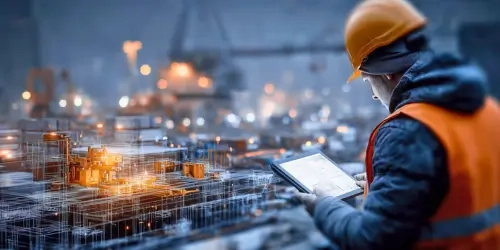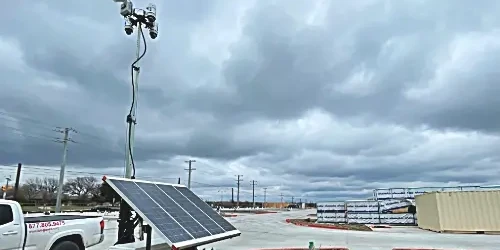Until recently, construction jobsites treated cybersecurity and worker safety as different challenges. IT departments focused on protecting servers and files. Safety managers concentrated on preventing accidents and injuries.
But jobsites have changed. Cameras, access controls, and sensors now live on the same networks that power emails and design files. When a cyberattack hits, files, servers, workers, equipment, and entire projects are at risk. That’s why cybersecurity and safety can no longer operate in separate lanes.
This article explores how those risks play out in the field, why collaboration is the only real solution, and what practical steps can help teams stay one step ahead.
The Shift from Isolated Systems to Connected Risks
Construction jobsite security once relied on simple, standalone systems. Surveillance cameras weren’t connected to the internet, and safety checks were logged on paper. IT had little involvement in site operations.
Today’s jobsite runs on a web of connected devices spanning mobile surveillance trailers, pole cameras, environmental sensors, and smart detection tools. They feed live data into cloud platforms so managers can respond in seconds, not hours.
But every connection introduces risk. Each camera, sensor, and detection unit is both a safety tool and a digital entry point. A single infected device can spread malware through the network or expose sensitive information.
When IT and safety work in silos, it’s easy for these gaps to go unnoticed. A construction jobsite might install a new PPE detection system without realizing it’s running outdated firmware. An IT admin might block a data port to improve safety, only to cut off live feeds to security dashboards.
On today’s connected jobsites, these "small" mistakes are system-level failures.
Collaboration changes that. When cybersecurity policies and safety operations align, every connected device becomes part of a managed network. IT can secure what safety depends on, while safety can report issues before they turn into vulnerabilities.
How Cyber Threats Disrupt Jobsite Safety
Mobile surveillance at construction jobsites is smarter than ever, and more exposed than most realize.
Take ransomware, for example. A single infection can freeze solar surveillance trailers, leaving large sections of the site without monitoring. No footage means no visibility, and no visibility means no way to verify incidents or respond to emergencies.
Phishing attacks are just as dangerous. If an attacker gains access to a shared safety account, they can pull camera feeds, edit footage, or wipe compliance logs. Those records are often vital for insurance or investigations, so losing them can mean lost evidence and serious liability.
Then there are data manipulation attacks, which are harder to spot but just as destructive. Imagine a hacker altering readings from environmental monitoring sensors, muting noise monitoring alerts that protect workers from hearing damage. These incidents breach data integrity, but also put people at real risk.
In every case, cybersecurity is both an IT safeguard and a safety measure. A secure network is the foundation that keeps every sensor, camera, and alert system working when it matters most.
Why a Unified Cyber and Safety Strategy Wins
When IT and safety teams share the same data, blind spots vanish. A single breach no longer means hours of guessing because every alert, sensor, and feed lines up in one view.
The benefits go far beyond protection. Fewer silos mean faster reaction times and less downtime. When cameras, detection systems, and environmental sensors report to one secure platform, both IT and safety know what’s happening in real-time. The site stays visible even when the network drops.
Perhaps most importantly, workers develop actual confidence in safety systems when they see them working properly day after day. If they see that, for instance, PPE and smoke sensors are tied into a single, well-secured system, they take those warnings seriously. Trust leads to proper usage, which leads to better safety outcomes.
Stellifii: One Platform, Total Visibility
Stellifii draws WCCTV’s mobile surveillance units, smart sensors, and environmental monitoring into a single cloud-based system, giving IT and safety teams access to identical, real-time information.
Live video, AI-driven alerts, air quality readings, noise levels, weather conditions, PPE compliance, and smoke or fire detection all feed into one dashboard. No switching between multiple apps, no delayed reports, and no miscommunication between teams. When something goes wrong (or threatens to), everyone knows instantly.
During the daytime, managers can monitor multiple sites and check diagnostics from a laptop or phone. At night, AI analytics scans feeds for intrusions, unusual activity, or safety hazards, escalating alerts in real time.
Real visibility, encryption, and 4G/5G connectivity make Stellifii a cyber-secure backbone for safety tech. Every device plugs into a network that’s built for both operational visibility and compliance. Stellifii brings data together, turns it into action, and gives IT managers confidence that protecting the network also protects the people on the ground.
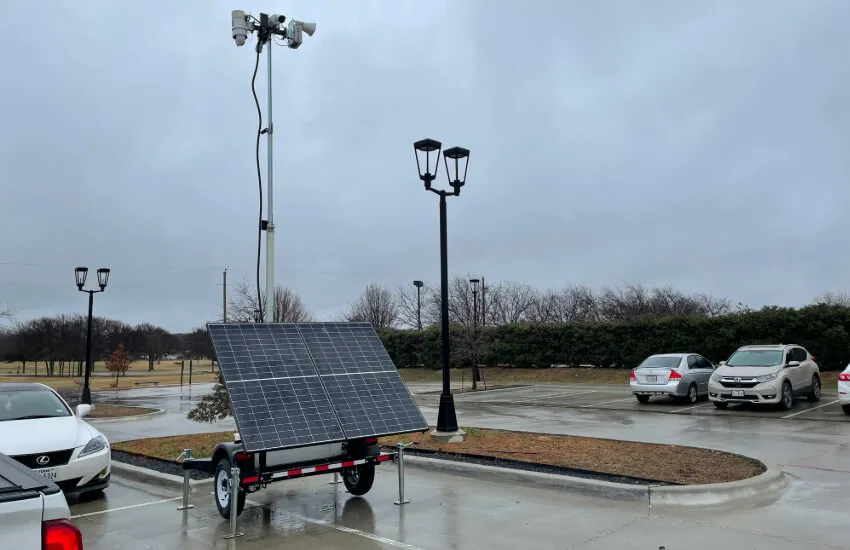
A 9-Step Roadmap for IT and Safety Teams
Here’s a sequence IT and safety teams can start applying immediately to prevent incidents.
1. Map Every Connected Device
List everything touching the network, including solar surveillance trailers, pole cameras, intrusion sensors, environmental monitors, and PPE detection units. Each one is a small computer that needs care and upkeep.
Stellifii discovers and labels all connected devices automatically, giving you a live inventory without chasing spreadsheets or emails. You see every camera, sensor, and live video feed in one view, making it easy to spot gaps before attackers do.
2. Segment Networks and Control Access
Separate critical systems from casual devices. Not every Wi-Fi connection should see video feeds or environmental data. Stellifii centralizes access with role-based permissions and multi-factor authentication, so the right people can access the right information while blocking attackers.
3. Build Redundancy Into Monitoring
Cameras fail, networks drop, and power cuts happen. Use solar surveillance trailers and pole cameras with local recording so that even if the cloud goes offline, sites stay visible, alerts trigger, and recorded evidence is preserved.
4. Keep Firmware and Passwords Current
Old firmware and reused passwords are the two doors most attackers walk through. Therefore, schedule quarterly updates and replace any hardware that can’t support signed firmware. You should also automate password rotation where possible. It’s this simple maintenance that protects millions in equipment and labor.
5. Encrypt All Data and Enable Secure Cloud Access
Video, sensor data, and worker records should travel encrypted and stay encrypted when stored. Stellifii supports AES-grade encryption and secure user authentication, so even if a laptop is stolen or a feed is intercepted, sensitive data stays secure and out of reach.
6. Train for Real Scenarios
Run drills where cameras go down or data gets locked. Let safety officers, IT staff, and site managers work together in the same room and simulate a security breach. You'll discover weaknesses you never knew existed.
7. Smart Detection and Edge AI
Alarms must work even if the cloud is unreachable. Stellifii integrates AI-powered analytics for PPE detection, smoke and fire, and intrusion. Alerts are verified and escalated in real time, so no incident slips through unnoticed.
8. Connect Sensors to Video
Environmental monitors aren’t background decoration. Feed their readings into your security dashboard so video automatically tags noise spikes, sudden wind changes, or air-quality alerts. It’s how one piece of evidence supports another. Start with:
9. Choose Vendors Built for Security
Every device, camera, and sensor should support encryption, signed firmware, and secure connectivity. Stellifii is built in-house, so we control hardware, software, and updates, with no third-party surprises. That means a single, consistent platform across every site, with direct support when needed.
Compliance Readiness Checklist
If a regulator or auditor walked onto your jobsite today, could you prove you’re compliant and secure? Here’s a quick way to find out:
-
Do IT and safety teams share a unified data platform?
-
Can you trace who accessed which camera or sensor feed, and when?
-
Are all devices encrypted and updated quarterly?
-
Do trailers and towers record locally in case of network loss?
-
Are smart detection systems (PPE, smoke, intrusion) connected and tested regularly?
-
Can you pull a compliance dashboard instantly without manual work?
If you hesitated on any of these, that’s where you should focus first.
Bringing It All Together
When IT and safety teams share visibility and leverage AI-powered detection with platforms like Stellifii, blind spots vanish. Real-time alerts, environmental insights, and connected devices all work together to keep workers safe, projects on track, and compliance records reliable.
Every jobsite can reach this level of control. It starts with mapping every connected device and linking every alert system, then aligning safety protocols with cybersecurity measures.
Contact WCCTV today and see how a connected approach to cybersecurity and safety transforms your jobsite.
FAQs
What are the most common cyberattacks on jobsites?
Construction sites face multiple threats, with phishing attacks and ransomware being particularly common. These can result in security breaches, exposure of sensitive data, or unauthorized access to personally identifiable information. Regular employee training and strong network policies reduce these risks.
How can companies protect against data breaches and identity theft?
Preventing data breaches requires a combination of cybersecurity measures, such as multi-factor authentication and encrypted communications. Access controls and network segmentation help ensure attackers cannot gain unauthorized access to customer data, bank account details, or project-sensitive information.
What role does technology like artificial intelligence play in site security?
Artificial intelligence helps analyse real-time data from cameras and sensors to identify potential risks before they result in devastating consequences. AI can detect anomalies, trigger alerts for intrusions, flag non-compliance events, and monitor environmental changes, enhancing both cyber and physical security across construction operations.
How should companies maintain a strong security strategy?
A robust security strategy combines regular security audits, employee training, and layered protection across all connected devices. For sites handling critical infrastructure or operating in the construction industry, proactive measures reduce significant risk from malicious attacks, protect national security, and ensure that business operations continue smoothly.
